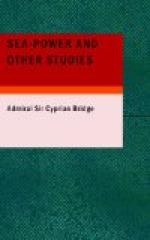Even when the Admiralty decided to suspend all administrative exemptions—or, as the phrase was, ’to press from all protections’—many persons were still exempted. The customary and statutory exemptions, of course, were unaffected. On the 5th November 1803 their Lordships informed officers in charge of rendezvous that it was ’necessary for the speedy manning of H.M. ships to impress all persons of the denominations exprest in the press-warrant which you have received from us, without regard to any protections, excepting, however, all such persons as are protected pursuant to Acts of Parliament, and all others who by the printed instructions which accompanied the said warrant are forbidden to be imprest.’ In addition to these a long list of further exemptions was sent. The last in the list included the crews of ’ships and vessels bound to foreign parts which are laden and cleared outwards by the proper officers of H.M. Customs.’ It would seem that there was next to no one left liable to impressment; and it is not astonishing that the Admiralty, as shown by its action very shortly afterwards, felt that pressing seamen was a poor way of manning the fleet.
Though the war which broke out in 1803 was not formally declared until May, active preparations were begun earlier. The navy had been greatly reduced since the Peace of Amiens, and as late as the 2nd December 1802 the House of Commons had voted that ’50,000 seamen be employed for the service of the year 1803, including 12,000 marines.’ On the 14th March an additional number was voted. It amounted to 10,000 men, of whom 2400 were to be marines. Much larger additions were voted a few weeks later. The total increase was 50,000 men; viz. 39,600 seamen and 10,400 marines. It never occurred to anyone that forcible recruiting would be necessary in the case of the marines, though the establishment of the corps was to be nearly doubled, as it had to be brought up to 22,400 from 12,000. Attention may be specially directed to this point. The marine formed an integral part of a man-of-war’s crew just as the seamen did. He received no better treatment than the latter; and as regards pecuniary remuneration, prospects of advancement, and hope of attaining to the position of warrant officer, was, on the whole, in a less favourable position. It seems to have been universally accepted that voluntary enlistment would prove—as, in fact, it did prove—sufficient in the case of the marines. What we have got to see is how far it failed in the case of the seamen, and how far its deficiencies were made up by compulsion.
On the 12th March the Admiralty notified the Board of Ordnance that twenty-two ships of the line—the names of which were stated—were ‘coming forward’ for sea. Many of these ships are mentioned in TheNaval_Chronicle_ as requiring men, and that journal gives the names of several others of various classes in the same state. The number altogether is thirty-one. The aggregate complements,




